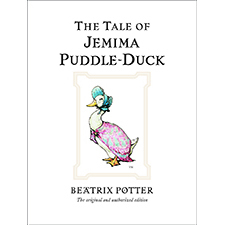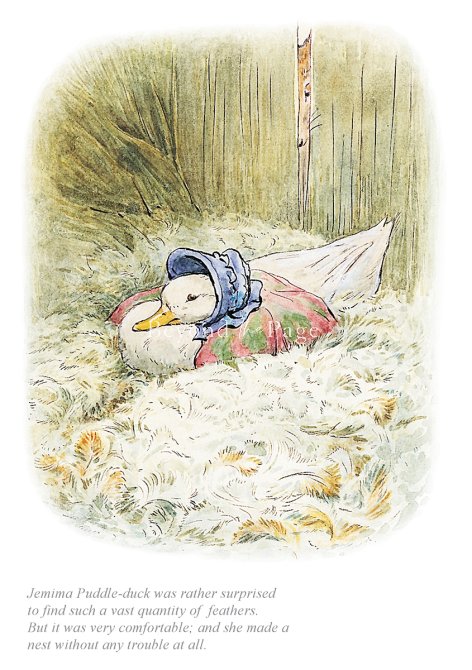We use cookies to make your experience better. To comply with the new e-Privacy directive, we need to ask for your consent to set the cookies. Learn more.
Beatrix Potter
Jemima was surprised to find a quantity of feathers
Official Collector's Edition Print. Hand numbered (unsigned) on fine art paper
| Image Size: | 17 x 22.5cm |
| Mounted Size: | 35 x 41cm |
| Overall Size: | 35 x 41cm |
| Edition Size: | 495 |
Presented in a conservation mount with a Certificate of Authenticity. From Beatrix Potter’s original illustrations for ‘The Tale of Jemima Puddle-Duck’

About the Artwork
THE TALE OF JEMIMA PUDDLE-DUCK published 1908
Beatrix Potter’s love of Hill Top and farming shine through this story. She painted her farm manager’s wife, Mrs Cannon, feeding the poultry, while the children Ralph and Betsy (to whom this farmyard tale is dedicated) are also illustrated. Kep the collie was Beatrix’s favourite sheepdog, and Jemima herself was a real duck who lived at Hill Top. She is a most popular character: self-important, naïve, but very endearing. The story also contains many delightful views of Sawrey: Jemima’s wood can still be seen, the view from the hills above the farm, across Esthwaite Water, has not changed, and the Tower Bank Arms is still the local village pub. This blend of fantasy and reality, so often to be found in Beatrix Potter’s work, gives a ring of truth to her imaginary world.
About the Artist
Beatrix Potter was born in London in 1866 and grew up living the conventionally sheltered life of a Victorian girl in a well-to-do household. She was educated at home by a governess with her brother Bertram. Her constant companions were the pet animal she kept which she enjoyed studying and sketching. On summer holidays she delighted in exploring the countryside and learning about plants and animals from her own observations. Beatrix Potter devoted most of her energy to the study of natural history – archaeology, geology, entomology and, especially, mycology. Fungi appealed to Potter’s imagination, both for their evanescent habits and for their coloration. Encouraged by Charles McIntosh, a revered Scottish naturalist, to make her fungi drawings more technically accurate, Potter not only produced beautiful watercolours, but also became an adept scientific illustrator. By 1896 Beatrix Potter had developed her own theory of how fungi spores reproduced and wrote a paper, ‘On the Germination of the Spores of Agaricineae‘. This was presented to a meeting of the Linnean Society on 1 April 1897 by one of the mycologists from the Royal Botanic Gardens, Kew, since women could not attend Society meetings. Her paper has since been lost. Beatrix Potter’s career as a children’s illustrator and storyteller began when The Tale of Peter Rabbit was published by Frederick Warne and Co. in 1902. The public loved it as soon as it appeared and Beatrix went on to produce on average two books a year until 1910.
We hope you enjoy viewing our collection of Beatrix Potter Collector's Edition prints.
.jpg)
